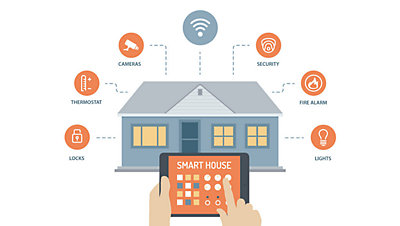Smart Home Lighting: 3 Options for Remotely Controlling Lights

Remember “The Clapper”? You know, the sound-activated light switch you could “clap on” and “clap off”.
Well, let’s just say remotely controlling your lights has come a very long way since 1986. You can now use smart home lighting to:
- Turn lights on/off from any web-enabled device
- Set ‘scenes’ that automatically adjust your lights based on triggers (like turning all lights off when you go to bed).
- And much more
If smart home lighting interests you, there are 3 different types of smart home lighting to choose from:
- Smart bulbs
- Smart plugs
- Smart switches
We’ll give you a brief overview of each of these options and our recommendation for which is best.
Smart bulbs
This is a bulb that connects to your home’s network or home automation hub. It looks and works just like a regular LED lightbulb. Just screw it into a bulb socket and you’re ready to go.
Benefits
- Easy to install
- Great way to get started with smart lighting because they don’t require any wiring changes — just screw in the bulb!
- Less expensive than most smart plugs or switches
Smart plugs
Smart plugs are small devices that plug into existing wall outlets. You then plug your lamps into the smart plugs, which connect wirelessly to your home automation system.
Benefits
- “Plug and play”– easy to install and operate
- More versatile than smart bulbs and smart switches as the plugs also work with other electronics such as a stereo system, tv and other small appliances.
- Some smart plugs come with advanced features that can monitor the electricity usage and estimates the monthly energy cost of the device plugged into the outlet
- Generally, it cost less than smart switches
Smart switches
Smart light switches simply replace your old light switches. They are hardwired into your home’s wall like a standard light switch and require a professional to install.
Benefits
- Able to control hardwired ceiling light/fan fixtures and track lighting
- Clean aesthetic since they’re installed within your wall
- Allows you to continue using the manual switch and the app (which you can’t do with bulbs and plugs)
So, which one should I get?
It really depends on your situation and the types of lights you want to add to your home automation system. Here are a couple of our recommendations.
For hardwired ceiling light/fan fixtures and track lighting
Your options: Smart bulbs or smart switches.
Our recommendation: Smart switches because they allow you to continue to use the physical switch with the smart app.
You see, if you turn off the smart bulb from a physical fixture or switch, your bulb is disconnected from your home network. That means you can’t turn it back on remotely from your smart device.
For lamps and other lighting fixtures that are not controlled by a switch
Your options: Smart bulbs or smart plugs.
Our recommendation: It really depends on what you want. For example:
- Smart bulbs if you are concerned with cost. They are generally cheaper (unless you have several lamps with multiple bulbs.)
- Smart plugs if you want versatility and added features. Smart plugs generally have more features, like measuring energy consumption. You can also use them to add your TV or other electronics to your home automation system.
A word of caution on compatibility
Many smart home automation systems are proprietary, meaning they don’t play nice together. So, make sure you do your homework on which brands/devices pair with each other.
Or you can contact a professional like BriteBox. We are a full-service electrical contractor in Atlanta that can help with all of your electrical service and home automation system needs.
Related Reading
Subscribe To Our Newsletter
Get up-to-date current news, promotions, and industry tips.
